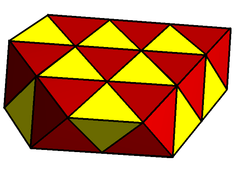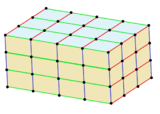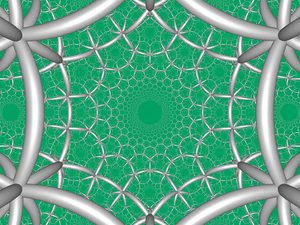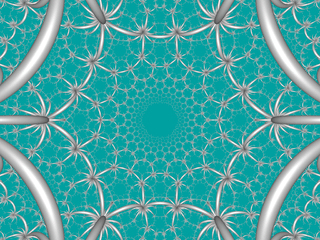Honeycomb (geometry)
In geometry, a honeycomb is a space filling or close packing of polyhedral or higher-dimensional cells, so that there are no gaps. It is an example of the more general mathematical tiling or tessellation in any number of dimensions. Its dimension can be clarified as n-honeycomb for a honeycomb of n-dimensional space.
Honeycombs are usually constructed in ordinary Euclidean ("flat") space. They may also be constructed in non-Euclidean spaces, such as hyperbolic honeycombs. Any finite uniform polytope can be projected to its circumsphere to form a uniform honeycomb in spherical space.

Classification
There are infinitely many honeycombs, which have only been partially classified. The more regular ones have attracted the most interest, while a rich and varied assortment of others continue to be discovered.
The simplest honeycombs to build are formed from stacked layers or slabs of prisms based on some tessellations of the plane. In particular, for every parallelepiped, copies can fill space, with the cubic honeycomb being special because it is the only regular honeycomb in ordinary (Euclidean) space. Another interesting family is the Hill tetrahedra and their generalizations, which can also tile the space.
Uniform 3-honeycombs
A 3-dimensional uniform honeycomb is a honeycomb in 3-space composed of uniform polyhedral cells, and having all vertices the same (i.e., the group of [isometries of 3-space that preserve the tiling] is transitive on vertices). There are 28 convex examples in Euclidean 3-space,[1] also called the Archimedean honeycombs.
A honeycomb is called regular if the group of isometries preserving the tiling acts transitively on flags, where a flag is a vertex lying on an edge lying on a face lying on a cell. Every regular honeycomb is automatically uniform. However, there is just one regular honeycomb in Euclidean 3-space, the cubic honeycomb. Two are quasiregular (made from two types of regular cells):
| Type | Regular cubic honeycomb | Quasiregular honeycombs |
|---|---|---|
| Cells | Cubic | Octahedra and tetrahedra |
| Slab layer |  |
 |
The tetrahedral-octahedral honeycomb and gyrated tetrahedral-octahedral honeycombs are generated by 3 or 2 positions of slab layer of cells, each alternating tetrahedra and octahedra. An infinite number of unique honeycombs can be created by higher order of patterns of repeating these slab layers.
Space-filling polyhedra
A 3-honeycomb having all cells identical within its symmetries is said to be cell-transitive or isochoric. A cell of such a honeycomb is said to be a space-filling polyhedron.[2]
Five space-filling polyhedra can tessellate 3-dimensional euclidean space translation only. They are called parallelohedra and there are 5 of them:
- Cubic honeycomb (or variations: cuboid, rhombic hexahedron or parallelepiped)
- Hexagonal prismatic honeycomb[3]
- Rhombic dodecahedral honeycomb
- Elongated dodecahedral honeycomb.[4]
- Bitruncated cubic honeycomb[5]
 cubic honeycomb |
 Hexagonal prismatic honeycomb |
 Rhombic dodecahedra |
 Elongated dodecahedra |
 Truncated octahedra |
| Cube (parallelepiped) |
Hexagonal prism | Rhombic dodecahedron | Elongated dodecahedron | Truncated octahedron |
|---|---|---|---|---|
 |
 |
 |
 |
 |
| 3 edge-lengths | 3+1 edge-lengths | 4 edge-lengths | 4+1 edge-lengths | 6 edge-lengths |
Other known examples include:
- Triangular prismatic honeycomb.
- The uniform gyrated triangular prismatic honeycomb
- The triakis truncated tetrahedral honeycomb. The Voronoi cells of the carbon atoms in diamond are this shape.[6]
- The trapezo-rhombic dodecahedral honeycomb[7]
- Isohedral simple tilings.[8]
Other honeycombs with two or more polyhedra
Sometimes, two [9] or more different polyhedra may be combined to fill space. Besides many of the uniform honeycombs, another well known example is the Weaire–Phelan structure, adopted from the structure of clathrate hydrate crystals [10]

Weaire–Phelan structure (With two types of cells)
Non-convex 3-honeycombs
Documented examples are rare. Two classes can be distinguished:
- Non-convex cells which pack without overlapping, analogous to tilings of concave polygons. These include a packing of the small stellated rhombic dodecahedron, as in the Yoshimoto Cube.
- Overlapping of cells whose positive and negative densities 'cancel out' to form a uniformly dense continuum, analogous to overlapping tilings of the plane.
Hyperbolic honeycombs
In 3-dimensional hyperbolic space, the dihedral angle of a polyhedron depends on its size. The regular hyperbolic honeycombs thus include two with four or five dodecahedra meeting at each edge; their dihedral angles thus are π/2 and 2π/5, both of which are less than that of a Euclidean dodecahedron. Apart from this effect, the hyperbolic honeycombs obey the same topological constraints as Euclidean honeycombs and polychora.
The 4 compact and 11 paracompact regular hyperbolic honeycombs and many compact and paracompact uniform hyperbolic honeycombs have been enumerated.
 {5,3,4} |
 {4,3,5} |
 {3,5,3} |
 {5,3,5} |
| 11 paracompact regular honeycombs | |||||||||||
|---|---|---|---|---|---|---|---|---|---|---|---|
 {6,3,3} |
 {6,3,4} |
 {6,3,5} |
 {6,3,6} |
 {4,4,3} |
 {4,4,4} | ||||||
 {3,3,6} |
 {4,3,6} |
 {5,3,6} |
 {3,6,3} |
 {3,4,4} | |||||||
Duality of 3-honeycombs
For every honeycomb there is a dual honeycomb, which may be obtained by exchanging:
- cells for vertices.
- faces for edges.
These are just the rules for dualising four-dimensional 4-polytopes, except that the usual finite method of reciprocation about a concentric hypersphere can run into problems.
The more regular honeycombs dualise neatly:
- The cubic honeycomb is self-dual.
- That of octahedra and tetrahedra is dual to that of rhombic dodecahedra.
- The slab honeycombs derived from uniform plane tilings are dual to each other in the same way that the tilings are.
- The duals of the remaining Archimedean honeycombs are all cell-transitive and have been described by Inchbald.[11]
Self-dual honeycombs
Honeycombs can also be self-dual. All n-dimensional hypercubic honeycombs with Schläfli symbols {4,3n−2,4}, are self-dual.
See also
| Wikimedia Commons has media related to Tilings of 3-space. |
References
- ↑ Grünbaum (1994). "Uniform tilings of 3-space". Geombinatorics 4(2)
- ↑ Weisstein, Eric W. "Space-filling polyhedron". MathWorld.
- ↑ Uniform space-filling using triangular, square, and hexagonal prisms
- ↑ Uniform space-filling using only rhombo-hexagonal dodecahedra
- ↑ Uniform space-filling using only truncated octahedra
- ↑ John Conway (2003-12-22). "Voronoi Polyhedron. geometry.puzzles". Newsgroup: geometry.puzzles. Usenet: Pine.LNX.4.44.0312221226380.25139-100000@fine318a.math.Princeton.EDU.
- ↑ X. Qian, D. Strahs and T. Schlick, J. Comp. Chem. 22(15) 1843–1850 (2001)
- ↑ O. Delgado-Friedrichs and M. O'Keeffe. Isohedral simple tilings: binodal and by tiles with <16 faces. Acta Crystallogr. (2005) A61, 358-362
- ↑ Gabbrielli, Ruggero. A thirteen-sided polyhedron which fills space with its chiral copy.
- ↑ Pauling, Linus. The Nature of the Chemical Bond. Cornell University Press, 1960
- ↑ Inchbald, G.: The Archimedean Honeycomb duals, The Mathematical Gazette 81, July 1997, p.p. 213–219.
Further reading
- Coxeter, H. S. M.: Regular Polytopes.
- Williams, Robert (1979). The Geometrical Foundation of Natural Structure: A Source Book of Design. Dover Publications, Inc. pp. 164–199. ISBN 0-486-23729-X. Chapter 5: Polyhedra packing and space filling
- Critchlow, K.: Order in space.
- Pearce, P.: Structure in nature is a strategy for design.
External links
- Olshevsky, George. "Honeycomb". Glossary for Hyperspace. Archived from the original on 4 February 2007.
- Five space-filling polyhedra, Guy Inchbald
- The Archimedean honeycomb duals, Guy Inchbald, The Mathematical Gazette 80, November 1996, p.p. 466-475.
- Raumfueller (Space filling polyhedra) by T.E. Dorozinski
| Fundamental convex regular and uniform honeycombs in dimensions 3–10 (or 2-9) | |||||
|---|---|---|---|---|---|
| Family | / / | ||||
| Uniform tiling | {3[3]} | δ3 | hδ3 | qδ3 | Hexagonal |
| Uniform convex honeycomb | {3[4]} | δ4 | hδ4 | qδ4 | |
| Uniform 5-honeycomb | {3[5]} | δ5 | hδ5 | qδ5 | 24-cell honeycomb |
| Uniform 6-honeycomb | {3[6]} | δ6 | hδ6 | qδ6 | |
| Uniform 7-honeycomb | {3[7]} | δ7 | hδ7 | qδ7 | 222 |
| Uniform 8-honeycomb | {3[8]} | δ8 | hδ8 | qδ8 | 133 • 331 |
| Uniform 9-honeycomb | {3[9]} | δ9 | hδ9 | qδ9 | 152 • 251 • 521 |
| Uniform 10-honeycomb | {3[10]} | δ10 | hδ10 | qδ10 | |
| Uniform n-honeycomb | {3[n]} | δn | hδn | qδn | 1k2 • 2k1 • k21 |
